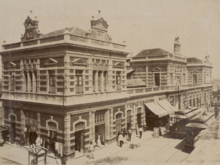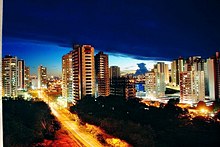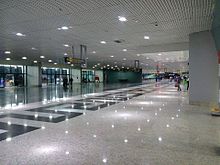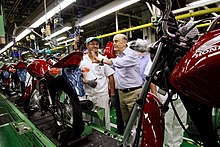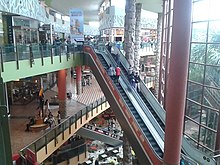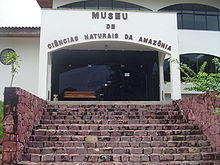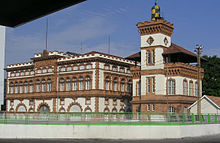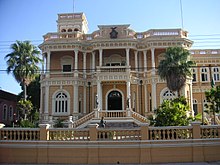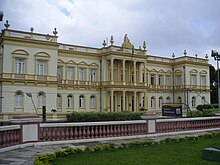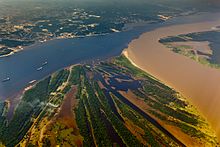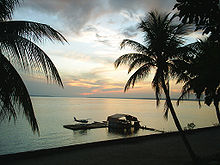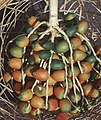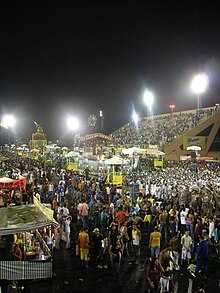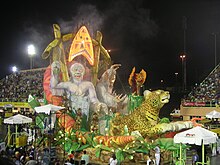Manaus
| Município de Manaus
Paris dos Trópicos
Manaus
Mãe dos Deuses Metrópole da Amazônia |
|||
|---|---|---|---|
|
Image montage to Manaus
|
|||
|
|
|||
| Coordinates | 3 ° 6 ′ S , 60 ° 1 ′ W | ||
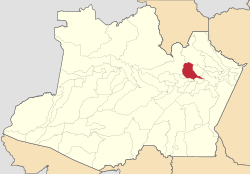 Location of the city of Manaus in the state of Amazonas Location of the city of Manaus in the state of Amazonas
|
|||
| Symbols | |||
|
|||
|
Motto "A Metrópole da Amazônia" "The metropolis of the Amazon" |
|||
| Basic data | |||
| Country | Brazil | ||
| State | Amazon | ||
| ISO 3166-2 | BR-AM | ||
| Região intermediária | Manaus (since 2017) | ||
| Região imediata | Manaus (since 2017) | ||
| Metropolitan area | Manaus | ||
| height | 92 m | ||
| Waters | Rio Negro | ||
| climate | tropical, Am | ||
| surface | 11,401.1 km² | ||
| resident | 1,802,014 (2010) | ||
| density | 158.1 Ew. / km² | ||
| estimate | 2,219,580 (July 1, 2020) | ||
| Parish code | IBGE : 1302603 | ||
| Postal code | 69000-001 to 69099-999 | ||
| Telephone code | (+55) 92 | ||
| Website | manaus.am (Brazilian Portuguese) | ||
| politics | |||
| City Prefect | David Almeida (2021-2024) | ||
| Political party | Avante | ||
| business | |||
| GDP | 70,296,364 thousand R $ 33,564 R $ per person (2016) |
||
| HDI | 0.737 (2010) | ||
Manaus [ mɐˈnau̯s ], officially Portuguese Município de Manaus , is the capital of the Brazilian state of Amazonas . It lies at the mouth of the Rio Negro in the Amazon . In the period between 1870 and 1910, the city became famous for the rubber boom , as the region was the only supplier of rubber for a long time . Today the place is mainly known for its historical buildings and as a tourist starting point for excursions into the very species-rich jungle that surrounds the city .
geography
Manaus is located at an altitude of 92 m on the left eastern bank of the Rio Negro , about eleven kilometers west of the confluence with the Rio Solimões in the upper Amazon basin in the middle of the jungle . From here on, the Rio Solimões is called the Amazon again, as it was before the Brazilian border. It is around 1,700 kilometers along the Amazon and 1,500 kilometers as the crow flies to the confluence of the Amazon in the Atlantic Ocean near Belém .
Manaus is the center of the metropolitan region of Manaus , which was initially founded in 2007 with the cities of Manaus, Iranduba , Manacapuru , Novo Airão , Presidente Figueiredo , Rio Preto da Eva , Itacoatiara and Careiro da Várzea . In 2009 Autazes , Careiro Castanha , Itapiranga , Manaquiri and Silves were added. In 2018, the metropolitan region of Manaus comprised 13 municipalities together with an estimated total area of 127,287.789 km² and 2,631,239 inhabitants as of July 1, 2018. This is 64% of the total population of Amazon, 14.4% of the Região Norte and 1.3% of the Brazilian state.
Manaus is divided into six zones (Zona Leste, Zona Norte, Zona Oeste, Zona Centro-Oeste, Zona Sul and Zona Centro-Sul), fourteen districts and 222 districts. The social center of the city is in the south in the Zona Sul directly on the Rio Negro around the harbor in the Centro district .
The city is also known as "Paris dos Trópicos" ("Paris of the Tropics") and "Metrópole da Amazônia" ("Metropolis of Amazonia").
climate
Due to the proximity to the equator (3 ° south latitude) there are only minor changes in the length of the day during the season . Therefore, instead of the four seasons, a distinction is only made between dry and rainy seasons. There is a humid tropical climate, which means that it is very hot all year round and the air is very humid. During the rainy season from December to May, heavy showers come down almost every day. The amount of precipitation per year is 2272 millimeters, which corresponds to two to three times the value achieved in Germany . The humidity is at least 95% at night and is also often very high during the day, so that the air temperature is perceived by people as even warmer than it actually is (see Perceived temperature ). The average temperatures of the individual months of a year vary only very slightly between 26 and 28 ° C. The maximum daytime temperatures are usually between 30 and 40 ° C, while at night temperatures between 20 and 30 ° C are reached.
Rainfalls in the Andes highlands of Colombia and Peru cause strong fluctuations in the water level of the Solimoes and, to a lesser extent, of the Rio Negros , which, however, also swell due to the backwater. Differences of up to 14 meters are achieved between the high water period from March to July and the low water period from August to February. A scale in the port of Manaus shows the levels of the different years.
| Manaus | ||||||||||||||||||||||||||||||||||||||||||||||||
|---|---|---|---|---|---|---|---|---|---|---|---|---|---|---|---|---|---|---|---|---|---|---|---|---|---|---|---|---|---|---|---|---|---|---|---|---|---|---|---|---|---|---|---|---|---|---|---|---|
| Climate diagram | ||||||||||||||||||||||||||||||||||||||||||||||||
| ||||||||||||||||||||||||||||||||||||||||||||||||
|
Average monthly temperatures and rainfall for Manaus
|
|||||||||||||||||||||||||||||||||||||||||||||||||||||||||||||||||||||||||||||||||||||||||||||||||||||||||||||||||||||||||||||||||||||||||||||||||||||||||||||||||||||
story
Founding and colonial times
The Spaniard Francisco de Orellana and his fellow travelers discovered the Rio Negro as early as 1542 and drove to the mouth of the Amazon. Manaus was founded in 1669 as a small Portuguese fort under the name "Forte de São José da Barra do Rio Negro". The population that settled around the fort grew slowly, and the first primitive church was built in 1695. In 1787 the fort had only 301 inhabitants, including 243 indigenous people, 47 white and eleven dark-skinned slaves. The city now consisted of two "districts", one of which housed the old church, the house of the vicar and the house of the commandant of the fort. In 1791 the fort became the seat of the governor, although it did not yet have city rights. The then commandant of the fort, Lobo d'Almada, had a palace built for the governor of Grão-Pará and Rio Negro. However, since he was not authorized to do so by Governor D. Francisco de Souza Coutinho, he was later accused of embezzling public funds. In 1804, the successor to Governor Coutinho wanted to pay tribute to the services of the late Commander d'Almada and moved the seat of government back to Manaus.
Empire
In 1823 the colonial areas of Grão-Pará and Rio Negro joined the Empire of Brazil .
On April 12, 1832, the fort's soldiers, led by Joaquim Pedro da Silva, revolted. The uprisings in which the commandant of the fort, Joaquim Filipe dos Reis, was killed, had been brought about by the failure to pay the wages . Subsequently, the provincial government of Pará sent troops led by Domingos Simões da Cunha Bahiana to put down the uprising. Although the defense of the province of Rio Negro was entrenched in an elevated area near the confluence of the Rio Negro and Rio Solimoes (Amazonas) with about 1,000 men and 30 cannons, the troops from Pará were victorious.
Over time, the city has had many different names. On July 25, 1833, the province of Pará, to which Manaus had belonged since the failed uprising, was divided into three provinces: Grão-Pará , Alto Amazonas and Baixo Amazonas . The fort belonged to the province of Alto Amazonas (Upper Amazonas), became a village with the division and was now called Manaus for the first time. Subsequently, the village was able to set up its own administrative and judicial structure.
On October 24, 1848, which is now considered the city's birthday, Manaus was given city status by law - at that time, however, under the name "Cidade da Barra do Rio Negro" - although there was not yet much that defines a city. For example, there was no public school system. On September 4, 1856, the governor Herculano Ferreira Pena finally called them Manaus again, based on the Indian tribe of the Manaós. The word means something like "Mother of God".
With a resolution of December 7, 1866, it was possible for the first time that travelers and traders from all countries could drive up the Amazon. This had enormous social and economic successes, so that, for example, the first long-haul routes were created. For example, from 1877 ships regularly ran between Manaus and Liverpool , and from 1881 also between Manaus and New York City .
Between 1872 and 1883, many job seekers came to the city, both from other parts of Brazil and from other parts of the world. Rubber exports soared at the same time, which is why Manaus became rich during the rubber boom . On May 24, 1884, slavery was abolished in the city.
republic
On November 21, 1889, the province of Alto Amazonas joined the newly proclaimed republic. Around 1890 Manaus was probably the most developed city in Brazil. At that time the city was also called the “Paris of the Tropics” because it was the only one in the country that had electric light and a drinking water and sewage system. During this time, many buildings such as the Palace of Justice (Palácio da Justiça) or the theater ( Teatro Amazonas ) were built, from which one can imagine the wealth of the time. Manaus became a cosmopolitan city as strangers of various professions came and settled here from all over the world. In the course of this prosperity, the electric tram was also built, which opened on August 1, 1899. It was the first tram in Brazil. A trip with her was relatively cheap, which is why many residents of all walks of life used her. The railway existed until February 28, 1957.
After the loss of the world monopoly on rubber in 1910, the city began to decline. Public buildings fell into disrepair due to lack of maintenance, the power grid failed and the tram line was shut down. The governor Plínio Coêlho set up a program for work that was decided on October 23, 1951 and included, among other things, the free trade port. On June 6, 1957 Manaus became president Juscelino Kubitschek for free trade zone declared (Zona Franca). Companies that manufacture in Manaus can now import their raw materials almost duty-free, which has led to an economic boom and a resurgence of public life in the city since the 1970s.
Manaus was in 2020 and will be severely affected by the COVID-19 pandemic in Brazil in 2021 .
Local politics
Executive: Manaus has been ruled by Mayor Amazonino Mendes , who belongs to the Partido Trabalhista Brasileiro (PTB) party , since January 1st, 2009 . Mendes was replaced on January 1, 2013 by Arthur Virgílio Neto ( Partido da Social Democracia Brasileira ), who held this position from 1989 to 1993. Neto prevailed against communist Senator Vanessa Grazziotin in the 2012 local election with 65.95% of the vote and against eight competitors in the 2016 local election with 55.96%. In the 2020 local elections in Brazil , David Almeida of the Avante party was elected city prefect for the period from 2021 to 2024 with 466,970 or 51.27% of the valid votes.
Before 1962 and between 1965 and the end of 1985 the mayors were appointed by the governor of the state of Amazonas, which explains the different lengths of the sometimes very short terms of office. Otherwise, they were elected by the city's citizens.
In addition to the mayor and the deputy mayor, there are 31 secretaries and the "Gabinete Civil". The secretaries all have their own specific area of responsibility, such as public transport or security. The Gabinete Civil works with the mayor and the deputy mayor.
The legislature is exercised by a city council made up of 41 elected representatives ( vereadores ) of the Câmara Municipal.
- See also : List of Mayors of the City of Manaus
City coat of arms
The sun on the upper part of the coat of arms (see picture above) bears the inscription November 21, 1889, the day on which the then province of Alto Amazonas , to which Manaus belonged, joined the proclamation of the republic. The picture above left shows the meeting of the two rivers Rio Negro and Amazonas ( Rio Solimões ), the so-called "Encontro das aguas" as well as two small boats that are located at the confluence. Furthermore, it should point to the discovery of the Rio Negro by Francisco de Orellana . The founding of the city or the "Forte de São José da Barra do Rio Negro" is shown at the top right. In the middle of the picture there are two people, a Portuguese soldier and an Indian figure. These symbolize the peace between the Portuguese and the Indians, which came about through the marriage of a chief's daughter to the Portuguese commander. On the left of them you can see the fort with the Portuguese flag, on the right there are houses that are supposed to represent the first houses of the city. The large lower part relates to the rubber boom . In the back you can see the river, in the foreground a rubber tree .
Population development
| year | resident | source |
|---|---|---|
| 1787 | 301 | |
| 1914 | 50,000 | |
| 1970 | 300,000 | |
| 1985 | 800,000 | |
| 1996 | 1,157,357 | |
| 2000 | 1,405,835 | |
| 2004 | 1,592,555 | |
| 2006 | 1,688,524 | |
| 2010 | 1,802,014 | |
| 2020 | 2,219,580 |
The population of Manaus as of July 2020 was 2,219,580 according to IBGE estimates. Based on data from 2010, Manaus is currently the seventh largest city in Brazil with 1,802,014 inhabitants, 51.19% women and 48.81% men. The district “Cidade Nova” (New City) is the largest district with 500,000 inhabitants, both in terms of population and area. It was founded by Governor José Lindoso to provide housing for people who came from all over Brazil looking for work in the Zona Franca. The Cidade Nova project was initially designed for 1,800 houses, but was expanded very quickly.
The population has increased rapidly over the past 50 years. This was due to the rapid industrial development on the one hand, but also to the birth rate of 4.74 children per woman on the other. In 1970 there were just 300,000 inhabitants, the population grew to over 800,000 in 1985 and 1,025,979 in 1990 to the current level, which makes up 60% of the population of the Amazonian state . According to the IBGE , 58% of today's residents are mixed race or Caboclos , i.e. descendants of different ethnic groups. 34% are white, 3% are dark-skinned and 4% are of Aboriginal descent. At 0.1%, Asians represent a very small minority.
The population density in the built-up urban area is 3914 inhabitants per square kilometer; if you look at the entire 11,401 square kilometer urban area, you get a value of 148. The relatively low value for a large city is partly due to the fact that there are only very few, smaller high-rise buildings .
Life expectancy at 73 years is relatively high compared to the rest of Brazil, while the infant mortality rate for children up to five years of age is 2.27%. 3.37% of the population are illiterate.
86.9% of the households are connected to the municipal power grid, 74.61% to the sewage disposal, 68.61% to the water supply and 96.54% to the garbage disposal. However, rubbish is also dumped in unsecured heaps north of the city. A positive development are high investments in the infrastructure, for example in 2002 in a new sewage treatment plant for 500,000 inhabitants. The previously operated system failed after a short period of operation and was without function for many years.
religion
Most of the residents profess to the Catholic Church and are therefore Christians . Manaus is the seat of the Roman Catholic Archdiocese of Manaus . The Protestant Church plays a rather minor role. Other religions such as Islam , Afro-Brazilian religions ( e.g. Candomblé ) or sects only appear sporadically.
Economy and Infrastructure
The city's electricity and water supply is guaranteed by the state-owned companies Electronorte and Agua Amazonas. Garbage collection and street cleaning are carried out by the city administration.
The garbage is not separated from the households, but collected completely, but there are already several companies in the plastics, paper and aluminum sector that do recycling. In some cases, these companies even buy up waste and sort it in order to guarantee their supply of raw materials.
Local public transport
There are no S-Bahn or U-Bahn trains, local public transport only consists of numerous bus lines. Such railway lines are currently not planned. You can get on the buses either through the rear door and off at the front (for articulated buses). In the case of two-axle buses, you get in through the front door and get out again at the back. A turnstile with a cashier is located between the two doors. He collects the fare, which is the same for each trip, regardless of the distance covered. Today there is also an electronic payment system with an NFC prepaid card, which is intended to replace cash due to the high number of robberies on buses.
There are six so-called terminals within the city, within which you can change free of charge. A terminal is a kind of fenced-in bus station used by buses on many different lines. The buses are always busy, especially during rush hour.
Some companies pay their workforce a contribution for the bus trip to and from work electronically on the prepaid card. Other, mostly larger, companies also offer their own bus service instead of the travel costs, which picks up employees from home in the morning and brings them back home in the evening.
The Manaus tram existed from 1899 to 1957 . It was the first tram in Brazil and was considered very cheap.
Long-distance rail and road transport
Apart from the roads to the smaller surrounding cities, there is only one road connection that leads to Venezuela via Boa Vista , the capital of the neighboring state of Roraima . This road, BR-174 , is the only overland route from Brazil to Venezuela. Otherwise Manaus can only be reached by ship or plane. There are regular boat connections along the Amazon to, for example, the cities of Parintins , Santarém and Belem.
There are currently no plans to build any further roads. An exception is the Transamazônica , which has even been partially completed, but has been overgrown by the jungle again in the vicinity of Manaus. So far , no further roads have been built for several reasons: On the one hand, environmentalists and IBAMA are resisting fiercely, as large areas of rainforest would have to be cleared for road construction. Furthermore, the natural conditions are very adverse, as the rivers in the region are very wide and in the rainy season they flood large parts of the jungle. In addition, Manaus is a relatively safe city due to its isolation from the rest of Brazil and does not want to give up this status by being connected to the road network. Ultimately, the distances to the nearest large cities are very large, so that an expansion of shipping and the airport is more advisable. There is also no railway line for the same reasons. In the region there is only the Madeira-Mamoré railway , which however has no connection to Manaus.
In 2008, the construction of an approx. 3.5 km long bridge over the Rio Negro began to replace the existing ferry connection to Manacapuru and Iranduba . The Ponte Rio Negro was inaugurated on October 24, 2011. In addition to the bridge, around 7.4 kilometers of new access roads were also created on both sides of the river.
port
The quays and docks of the port are floating docks, as the water level sometimes fluctuates by up to fourteen meters between the rainy and dry seasons. They are 300 meters long and were made between 1900 and 1902 by English engineers from B. Rymkiewicz & Comp. built. Today they are under monument protection. After the opening of the port, it quickly developed into the center of the city, where cafes, bars, restaurants, fashion boutiques and English import companies settled. Even today, the port is the center of the city and there are many shops nearby.
The port is the most important transshipment point for goods in the Amazon region, as there are only a few roads and no railway line. Both goods and passengers are carried in the typical multi-decker Amazon boats. An alternative to the Panama Canal is being worked on in cooperation with Ecuador . Via the multimodal Manta-Manaus axis , goods should arrive 30 days earlier from the Pacific coast via the Andes by land and along the Amazon.
At the beginning of the 1960s, the port was expanded for container traffic, because due to the width and depth of the river, ocean-going ships can easily sail to Manaus. Since then, in addition to the sometimes improvised landing stages for the Amazon boats, there has been a well-developed ocean-going port that is used by cruise ships and container freighters. The floating port jetty is considered a masterpiece of engineering, as it allows year-round operation.
Manaus International Airport
Manaus Eduardo Gomes International Airport opened on March 31, 1976 and is fourteen kilometers from the center of the city. It has a runway 2,700 meters long and 45 meters wide, two freight terminals, which were inaugurated in 1976 and 1980, respectively, and two passenger terminals with four arrival and eight departure halls, seven hangars and six docking points for aircraft, five of which are fixed and one movable finger .
The annual passenger volume is around 1.8 million people, making it fifth among the busiest airports in Brazil. If you consider the cargo volume, which amounts to 33,785 tons per year, the airport is actually the one with the second largest in Brazil.
education
Manaus is home to numerous educational institutions, both state and private. The most famous secondary school is the Fundaçao Nokia, which is located in the middle of the industrial area. The best known and largest university is the state Universidade Federal do Amazonas (UFAM).
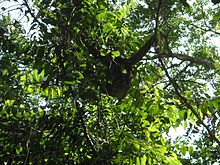
The Universidade Federal do Amazonas offers technical courses such as electrical engineering or computer science as well as medicine, law, biology and many subjects for teaching. It was founded on January 17, 1909 under the name Escola Universitária Livre de Manáos . This made it the first university in Brazil. On July 13, 1913, it was renamed Universidade de Manaós , i.e. University of Manaós. On March 13, 1964, it was finally re-established by law at a new location within the city through the amalgamation of several institutes, including the Institute for Law of the old university. On January 17, 1965, the new university began operations under the new name “Universidade do Amazonas”. It was only given its current name in 2002. The Universidade Federal do Amazonas is located in the middle of a jungle area and, like many universities in Brazil that were built during the military dictatorship, has only one entrance and exit. This design made it easy for the military to isolate students from the outside world in the event of a student revolt. Because of its location in the middle of the jungle, the campus is dominated by monkeys, sloths and wild dogs at night and early morning . The jungle inhabitants can also be observed during the day.
Economy and Zona Franca
After the end of the rubber boom , the economy in Manaus fell to the ground. That is why the free trade zone ( Zona Franca de Manaus ) was created in 1957 , in which companies are granted tax and tariff concessions to compensate for the unfavorable traffic situation. As a result of these perks, more than 450 companies settled in the city, creating around 120,000 direct jobs and another 350,000 indirect jobs. You can also shop in the city center, in the actual “Zona Franca”, duty-free and tax-free.
The companies based in Manaus are now mainly producing chemical and technical products such as motorcycles (BMW, Denso , Honda , Visteon and Yamaha ), bicycles, televisions and computer monitors ( Fujitsu , LG , Panasonic , Philips , Sanyo , Sharp and Thomson ), and cell phones ( Nokia , Samsung , Sagem ), DVDs with accessories ( Seiko and Sony ) and air conditioning systems valued at approximately 19 billion US dollars a year, and some developed.
Further, based in Manaus companies are Gillette , Kodak , Minolta , Pepsi , Sony Music and Xerox , as well as the largest domestic companies, Quartz Eletron Indústria e Comércio S / A . The industrial area in which most of these companies are located is called "Distrito Industrial Castelo Branco" and is located in the southwest of the city.
Today it is the fourth richest city in Brazil after São Paulo , Rio de Janeiro and Brasília due to its great economic power and tourism . However, after the withdrawal of the Colombian FARC from the drug cultivation region , the large, barely controllable free trade zone has developed into a new center of trade in cocaine , which is shipped via the many tributaries of the Amazon to Manaus, from here to the ports of northeast Brazil and from there to Europe will.
Shopping centers
In addition to the numerous shops and stores in the city center around the Teatro Amazonas and the even more numerous street stalls throughout the city, there are some large shopping centers.
The Amazonas Shopping is 86,800 square meters, the largest mall in the state of Amazonas . It opened on November 7, 1991 and is located north of the center near the Sambodromo at the intersection of Avenida Darcy Vargas and Avenida Djalma Batista. In addition to shops, fast food restaurants and banks, it also houses a six-screen cinema.
Studio 5 is located at the end of the industrial district facing the center and, like Amazonas Shopping, houses several shops, fast food restaurants and a cinema with several halls. On the premises of Studio 5 there is also the Felice restaurant, which offers freshly brewed German-style beer.
Shopping Cecomiz is a very small shopping center housed in two barracks very close to Studio 5. Besides these there are other shopping centers, the largest of which are Manauara Shopping, Ponta Negra Shopping and Samaúma Park Shopping.
Culture and sights
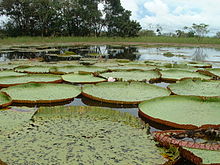
The main tourist attraction is the jungle surrounding the city, which is considered to be the region with the greatest biodiversity in the world. It is estimated that between five and ten million species live in the region around Manaus. The tourism industry has made use of this fact and offers numerous excursions into the jungle or overnight stays in jungle hotels.
Museums
The Museu do Homem do Norte (Museum of the North Man) shows exhibits from the life of the people of the north of Brazil, such as small huts, boats, weapons and tools that the people living in the jungle still use to this day.
The Museu do Índio has similar exhibits, the difference being that the focus here is on the life of the Indians. It shows more than 3,000 exhibits such as ceramics, hunting weapons and musical instruments of Indian peoples who are or were at home on the upper reaches of the Rio Negros.
The Museu de Ciências Naturais da Amazônia is significantly larger than the two above-mentioned museums. It is a natural history museum, in which mainly the fauna of the jungle and the Amazon is presented. The focus here is on insects and fish. The large number of exhibits gives an idea of the biodiversity of the Amazon region. The showpiece of the collection is a two-meter-long, living arapaima . The museum is located in the Asian quarter of Manaus, relatively far from the center of the city. It was built by a Japanese butterfly specialist at their own expense. It should be permanently closed.
Buildings
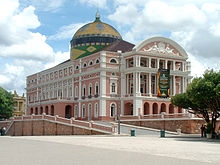
The Teatro Amazonas is an opera house in the style of the Italian Renaissance that seats 685 people. It is located in the historic city center near the harbor and is now the city's landmark. Construction began in 1884 and the inauguration took place in 1896.
The market continues to this day in the market hall at the port ( Mercado Municipal Adolpho Lisboa ). In addition to food such as meat, fish and exotic fruits, you can also buy souvenirs such as T-shirts and handicrafts. The market hall was built on the model of Les Halles in Paris and opened on July 15, 1883. The plans for their iron framework are from Gustave Eiffel . It was imported from Liverpool by Francis Morton and assembled in Manaus.
The Alfândega is the former customs house at the port, which is now a listed building. It was introduced and assembled in prefabricated blocks from England in 1906 by English engineers .
The Palácio Rio Negro was built in 1910 as a residence by the German rubber trader Waldemar Scholz and was therefore also known under the name “Palacete Scholz”. From the rubber trade, Scholz had become rich and one of the most influential men in town. With the end of the rubber boom and the First World War, which brought Scholz's connections to Germany to a standstill, he ran into financial difficulties. So he put a mortgage on his palacio and went back to Europe. Due to the mortgage, the Palacio became the property of Luiz da Silva Gomes, who sold it to the Amazonas state in 1918. From this time the Palacio served as the seat of government up to and including 1995. Since 1996 the well-preserved building has been a cultural center (Centro Cultural Palácio Rio Negro) and museum, which can be visited with English or Portuguese-speaking tours. In 2003, the governor of the Amazonas state began to hold meetings with important figures such as heads of government from other states in the Palacio.
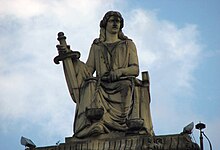
The Palácio da Justiça (Palace of Justice) is the city's former courthouse, just across from the Teatro Amazonas. Today the building only serves as a tourist attraction. In the palace itself you can see the premises, including the former courtrooms, and from time to time mock court hearings take place. On April 18, 1894, the governor Eduardo Ribeiro signed the contract for the construction of the two-story Palacio with an area of more than 5,000 square meters with the company Moers & Moreton . In 1900 the building was opened by the new governor José Cardoso Ramalho Júnior . A special feature of the Palace of Justice is the figure of Justitia on the roof, as she does not wear a blindfold, as is usually the case.
The Cathedral Cathedral De Nossa Senhora Da Conceição was completed in the 1877th Construction began in 1858, eight years after the old, primitive church from 1695 was destroyed. It is near the port at the Alfândega.
Parks
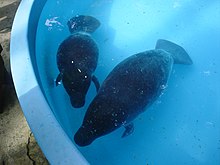
The Bosque da Ciência (Forest of Science) is a 130,000 square meter educational forest in the middle of town. It is affiliated with the INPA (Instituto Nacional de Pesquisas da Amazônia), which works with the Max Planck Society , among others . In the forest itself you can observe different animal species (such as manatees , various monkeys and alligators ), some of which are kept free in the forest, some in enclosures similar to zoos. In addition, the House of Research (Casa da Ciência), which shows INPA's research, is located in the forest.
The relatively small zoo ( CIGS - Centro Integrado de Guerra na Selva ) mainly focuses on the fauna of the surrounding jungle. For example, monkeys, jaguars and snakes are among the inhabitants.
The Mindú Park (Parque do Mindú), also called "Parque Dez", is a 330,000 square meter forest area only six kilometers northeast of the center. Many locals and tourists use it for walks, to visit the orchid house located here or to watch butterflies, primates or many species of insects. Numerous events such as theater performances take place here at the weekend. On Sundays, regional coffee specialties are mainly sold to tourists.
nature
The Encontro das Aguas (meeting of the waters) denotes the confluence of the Rio Solimões, as the Amazon is called up to this point, and the Rio Negro. The special thing about it is that both have very different colors. The water of the Rio Solimões is brownish-yellow, that of the Rio Negro is black; The latter is caused by the high content of humic acids and fulvic acids , which have been washed away by the rain in its 720,114 square kilometer catchment area from the already heavily depleted, sandy soils of the Terra Firme . The rivers flow side by side for eleven kilometers in the same river bed before their waters mix and the river becomes a uniform color again. The colored borders of the two rivers ( white and black water rivers ) can be clearly seen both on satellite images and from a ship. The confluence is about ten kilometers from Manaus and can be reached in about an hour by boat.
The reasons for this natural event lie in the different properties of the rivers. On the one hand, the Rio Negro has a relatively acidic pH value of 3.5 , which comes from the humic substances present in the water, while the Rio Solimoes (Amazonas) has a basic pH value of 7.5. The flow speed of the two rivers differs by a factor of three. The Rio Solimoes flows with 7.5 kilometers per hour, the Rio Negro with 2.5 significantly slower. Due to the color of the two rivers, their temperatures also differ. While the brown Rio Solimoes is always below 22 degrees (Celsius), the black Rio Negro reaches temperatures above 28 degrees. Due to the different temperature of the rivers, their density also differs significantly. In Presidente Figueiredo , 107 kilometers to the north, there are a large number of smaller and larger waterfalls around the formerly independent city. Some of them are in freely accessible areas, others on private property. Both locals and tourists use the opportunity to bathe in many cases.
beaches
Despite the piranhas and nocturnal alligators , bathing around Manaus is relatively safe. There are numerous beautiful sandy beaches by the rivers, the best known are Praia da Lua (Moon Beach), Praia Dourada and Praia do Tupé.
The Ponta Negra is both a promenade and the inner city beach of the Rio Negros. There are bars, beach volleyball fields and the exclusive Hotel Tropical, which has its own small animal zoo. The Ponta Negra is thirteen kilometers to the northwest from the city center. From time to time smaller festivals and other events take place here.
Culinary specialties
The fish dishes with fish from the region are particularly typical of Manaus cuisine. The variety of fish is very large, which is why there are a lot of fish dishes. Also typical is tacacá, a broth made from the juice of the manioc root with crabs and jambú . Of course, there is also the Brazilian national dish Feijoada in Manaus .
Just as typical for the city are the many different fruits, almost unknown in Europe, almost all of which are also offered as juices and which come from the region. Worth mentioning here include Graviola , Cupuaçu , Açaí , Jenipapo , Bacuri , Pupunha and Tucumã .
music
A very popular style of music is the forró (pronounced foho). There are numerous venues in the city where Forró is danced, especially on weekends.
The Axé , originally from Salvador da Bahia , is also very popular, as is Carimbó . Originally, Axé was music that was only performed during Carnival. In the meantime, however, there are music groups and bars that play Axé all year round.
Festivals / celebrations
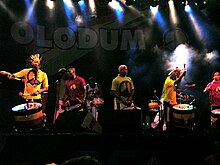
In the run-up to the actual carnival (January / February), concerts by carnival bands such as Olodum take place at various locations . These concerts usually start around 8 p.m. and last until the early hours of the morning. Several bands, some of which are very well known in Brazil, appear one after the other.
The real highlight of the carnival, the parade of the samba schools, takes place on two consecutive days. As in Rio de Janeiro, the venue is the so-called Sambodromo. This is an approximately 500 meter long street, which is lined to the right and left by grandstands that can hold more than 100,000 spectators.
The samba schools pull one after the other with their percussion troupe, their carriages, the dance couples, samba dancers and dance groups through the Sambodromo. The spectacle lasts around an hour per school. At the beginning of each evening (8 p.m.) it is the turn of the smaller schools, but the later the evening gets, the bigger the floats and the more splendid the costumes get. The two favored schools perform at around 5 a.m. each night.
The Bumba-meu-boi festival , which also takes place in the Sambódromo, is similar to the more popular one in Parintins . There are also two “teams”, the blue Boi Caprichoso and the red Boi Garantido, competing against each other.
Smaller stages will be set up along the Sambodromo, on which the dancers of both teams will then compete in groups of four. Now the bands of the teams take turns moving through the Sambodromo and performing their self-composed pieces. There are separate dance steps for each song. The dancers on the stages dance to the songs and behind the car that drives the band through the Sambódromo, anyone who wants to can dance along. At the end of the two-day competition, a jury will decide which team has won.
The festival always takes place around the city's birthday on October 24th. There is also another boi festival, the so-called Carnaboi , which takes place shortly before Carnival and is similar to Bumba-meu-boi. It derives its name from the Portuguese word for carnival (Carnaval).
The Amazonas de Ópera festival takes place in April and May. During the festival, various operas are performed in the Teatro Amazonas .
During the Folklore Festival ( Festival Folchlórico do Amazonas ) in June, various folkloric events take place, including festivals where the locals wear historical clothing and, for example, re-enact weddings from earlier days. The highlight on the 29th of the month is the St. Peter River Procession (Procissão Fluvial de São Pedro), during which hundreds of boats go out onto the Rio Negro to honor the patron saint of the fishermen.
Sports
Manaus was one of the twelve venues for the 2014 World Cup in Brazil. A new stadium was built for this, the Arena da Amazônia . The previous stadium “ Vivaldão ” with a capacity of 15,000 spectators was demolished in 2011 for this purpose.
The São Raimundo Esporte Clube football club plays in the Brazilian third division ( Série C ).
Personalities
sons and daughters of the town
- Cláudio Santoro (1919–1989), composer
- Francisco Xavier de Albuquerque (1926–2015), lawyer and President of the Brazilian Supreme Court (1981–1983)
- Eduardo Koaik (1926–2012), Roman Catholic clergyman, Bishop of Piracicaba
- Terezinha Morango (* 1936), Miss Brasil 1957 and second in the Miss Universum election
- José Augusto Branco (* 1942), actor with the Brazilian television channel Rede Globo
- Antônio Calmon (* 1945), screenwriter
- Márcio Souza (* 1946), writer (e.g. "Mad Maria")
- Jacson Damasceno Rodrigues (1948–1998), Catholic clergyman, auxiliary bishop in Manaus
- Djalma Limongi Batista (born 1950), filmmaker
- Vinícius Cantuária (* 1951), singer and composer
- Milton Hatoum (* 1952), writer and professor of literature at UFAM and the University of California at Berkeley
- Aurélio Michiles (* 1952), filmmaker
- Wallace Souza (1958-2010), television presenter
- José Albuquerque de Araújo (* 1968), Roman Catholic clergyman, auxiliary bishop in Manaus
- Daniel Pellizzari (* 1974), writer and translator of literary texts
- Malvino Salvador (* 1976), actor with the Brazilian television channel Rede Globo
- Andrezza Martins das Chagas (* 1977), Brazilian-Georgian beach volleyball player
- Marcelo Mourão Gomes (* 1979), solo dancer of the ' American Ballet Theater ' in New York , USA
- Antonio Pizzonia (* 1980), Formula 1 racing driver
- Armando Camargo (* 1982), racing cyclist
- Hiziel Souza Soares (born 1985), football player
- Hamilton Soares de Sá (* 1991), football player
Personalities who have worked on site
- Amazonino Mendes (* 1939), Mayor of Manaus from 2009 to 2013
literature
- Alberto Vazquez-Figueroa: Manaos. Plaza & Janés, Barcelona 1986, ISBN 978-84-01-32162-7 .
- Leo A. Despres, Manaus: Social Life and Work in Brazil's Free Trade Zone. State University of New York Press, Albany 1991, ISBN 978-0-7914-0537-6 .
- Ottaviano and Elizabeth De Fiore: Brazil. 4th edition. Baedeker, Ostfildern 2003, ISBN 3-89525-011-2 .
- John Noble, Andrew Draffen, Robyn Jones, Chris AcAsey, Leonardo Phineiro: Brazil. Lonely Planet, London 2002, ISBN 1-86450-146-4 .
- Benno Kroll, Photos: René Burri: Manaus: Heirs of Fall . In: Geo-Magazin. Hamburg 1978, 10, pp. 142-156. “The city in the Brazilian jungle has become rich and impoverished in rubber. Now, 60 years later, hundreds of thousands are hoping for a new boom. ”Informative experience report.
Web links
- City website (Brazilian Portuguese)
- Universidade Federal do Amazonas (Brazilian Portuguese)
- Alphabetical list of neighborhoods in the Portuguese language Wikipedia
- INPA - Institute for Research and Conservation of the Ecological Amazonia (Brazilian Portuguese)
Individual evidence
- ↑ a b c d IBGE : Manaus - Panorama. Retrieved September 20, 2020 (Brazilian Portuguese).
- ^ Atlas do Desenvolvimento Humano do Brasil: Manaus, AM. In: atlasbrasil.org.br, accessed June 17, 2021 (Brazilian Portuguese).
- ^ A Região Metropolitana de Manaus . Observatorio da A Região Metropolitana de Manaus. (Portuguese) Retrieved July 27, 2021
- ↑ manaus.am.gov.br ( Memento from May 6, 2007 in the Internet Archive )
- ↑ manaus.am.gov.br ( Memento from May 6, 2007 in the Internet Archive )
- ↑ a b manaus.am.gov.br ( Memento from March 28, 2007 in the Internet Archive )
- ↑ manaus.am.gov.br ( Memento from April 27, 2007 in the Internet Archive )
- ↑ manaus.am.gov.br ( Memento from May 7, 2007 in the Internet Archive )
- ↑ manaus.am.gov.br ( Memento from May 7, 2007 in the Internet Archive )
- ↑ manaus.am.gov.br ( Memento from May 6, 2007 in the Internet Archive )
- ↑ manaus.am.gov.br ( Memento from April 27, 2007 in the Internet Archive )
- ↑ manaus.am.gov.br ( Memento from April 27, 2007 in the Internet Archive )
- ↑ manaus.am.gov.br ( Memento from April 27, 2007 in the Internet Archive )
- ↑ manaus.am.gov.br ( page no longer available , search in web archives ) Info: The link was automatically marked as defective. Please check the link according to the instructions and then remove this notice.
- ↑ a b manaus.am.gov.br ( Memento from April 27, 2007 in the Internet Archive )
- ↑ a b manaus.am.gov.br ( Memento from May 7, 2007 in the Internet Archive )
- ↑ manaus.am.gov.br ( page no longer available , search in web archives ) Info: The link was automatically marked as defective. Please check the link according to the instructions and then remove this notice.
- ↑ a b manaus.am.gov.br ( Memento from May 7, 2007 in the Internet Archive )
- ↑ a b c manaus.am.gov.br ( Memento from April 27, 2007 in the Internet Archive )
- ↑ Christian Heinrich: Dying in Manaus should be a warning to the world , in: Spektrum.de, January 22, 2021; Jan Christoph Wiechmann: The Warning of the Dead, in: Stern No. 11, March 11, 2021, pp. 56–65.
- ↑ Arthur Virgílio Neto tem votação histórica em Manaus. (No longer available online.) Archived from the original ; Retrieved November 25, 2012 .
- ↑ Artur Neto 45 , website Eleições 2016. Retrieved on May 21, 2017 (Portuguese).
- ↑ Results - TSE. In: resultados.tse.jus.br. Retrieved January 26, 2021 .
- ↑ manaus.am.gov.br ( Memento from April 27, 2007 in the Internet Archive )
- ↑ manaus.am.gov.br ( Memento from March 29, 2007 in the Internet Archive )
- ↑ manaus.am.gov.br ( Memento from August 8, 2007 in the Internet Archive )
- ↑ a b c d ibge.gov.br
- ↑ a b c d portalbrasil.net
- ↑ ibge.gov.br
- ↑ a b ibge.gov.br
- ↑ ftp://ftp.ibge.gov.br/Estimativas_de_Populacao/Estimativas_2013/estimativa_2013_dou.pdf
- ↑ a b c d ibge.gov.br
- ↑ manaus.am.gov.br ( Memento from April 22, 2007 in the Internet Archive )
- ↑ ambientebrasil.com.br ( Memento from September 27, 2007 in the Internet Archive )
- ↑ MANAUS AMAZONAS BRAZIL EXPEDITIONS TOURS YOUR SPECIALISTS ON SITE Info Photo Travel Hotel - Manaus History. In: manaus-amazonas.com. February 28, 1957, accessed May 22, 2018 (manaus, history).
- ↑ CCPY update 100 wald.org
- ↑ Brazil: Mega bridge over Rio Negro in the Amazon inaugurated President Dilma Rousseff inaugurated the controversial mega bridge over the Rio Negro on Monday (24th) in Manaus in the Amazon. Initiated as part of the Economic Acceleration Program (PAC). Investment of 1.099 billion reais - the equivalent of around 470 million euros and more than twice as much as originally estimated - the remote towns between the Rio Solimões and the Rio Negro can now be reached more easily and quickly via the “Ponte Rio Negro”. November 24, 2011
- ↑ manaus.am.gov.br ( Memento from May 6, 2007 in the Internet Archive )
- ↑ aci.rgis.ch ( Memento from February 22, 2016 in the Internet Archive )
- ↑ manaus.am.gov.br ( Memento from April 27, 2007 in the Internet Archive )
- ↑ Alexander Busch: A violent scenario is brewing in the Amazon, the consequences of which will also be felt in Switzerland. In: NZZ , April 6, 2017.
- ↑ 3sat.de ( Memento of the original from February 20, 2009 in the Internet Archive ) Info: The archive link was inserted automatically and has not yet been checked. Please check the original and archive link according to the instructions and then remove this notice.
- ↑ manaus.am.gov.br ( Memento from April 27, 2007 in the Internet Archive )
- ↑ manaus.am.gov.br ( Memento from April 27, 2007 in the Internet Archive )
- ↑ manaus.am.gov.br ( Memento from March 31, 2007 in the Internet Archive )
- ↑ manaus.am.gov.br ( Memento from May 7, 2007 in the Internet Archive )
- ↑ water types of Amazonia . Planet knowledge





